In this lesson, we are going to see the different scenarios we can have when managing stock concerning the ownership, the responsible for managing it and for storing it.
DIFFERENT ROLES IN THE STOCK MANAGEMENT
First of all, we are going to define the different roles or stakeholders that we can have. A combination of who is who in each case will give us different possible scenarios.
Owner
The stock owner is independent of where the stock is located or who is managing it.
The owner has purchased or manufactured this stock, and it is contained in the balance sheet of its company as inventory.
The owner does not change with the movement of the stock. It is only changed when there is a purchase or sale.
Custodian
The custodian is the owner of the warehouse where the stock is located at a given moment.
It is the company that has direct physical access to the stock.
Party entitled to dispose
This is the organization that, at a given moment, decides what to do with the stock. For instance, it decides if it must be moved to a different location.
It is important to distinguish it from the owner because, as we will see, not always the owner is the party entitled to dispose of the stock.

POSSIBLE SCENARIOS
Scenario I
The most simple scenario is that one in which the three of the different roles are taken by the same company.
So, for instance, we can have stock in one plant (custodian), that belongs to the company that owns that plant (owner) and that is subjected to the decision of how to use it by the company.
There could also be a case, where the stock of two plants is stored in an external warehouse (owned by the same company). But as we see there are no roles assigned to different companies.
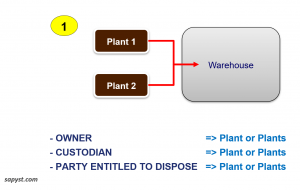
Scenario II
In the scenario II, we have a new stakeholder. Imagine that some of the stock is required to be stored in third-party warehouse.
Following the example of the scenario I, the owners and parties entitiled to dispose it continue to be the two plants. But now the custodian is this third-party (a Logistic Service Provider for instance).
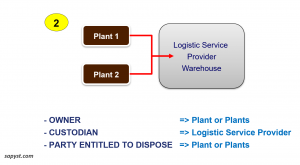
Scenario III
In the scenario III, we receive in our warehouse or plants, some stock from our vendors, but we haven’t yet purchased it. We could delay the purchase till we use it in our processes for instance.
In this case, the owners are still the vendors (till the purchase is complete). But the custodian and party entitled to dispose of it are these two plants.
This stock already in our plant but owned by vendors is called stock in consignment.
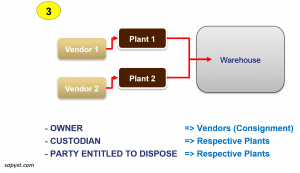
Scenario IV
In the scenario IV, this stock that we have received from our vendors but not yet purchased is stored in third-party warehouse.
So the owners remain the vendors, but now the custodian is this Logisitic Service Provider and the Party entitled to dispose of it, the two Plants.
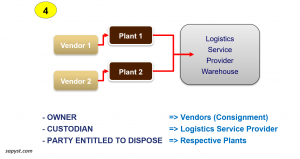
Scenario V
In this scenario, we have already sold some stock, but it has not yet been delivered or picked up by the customers.
So the owner are our customers, but the custodian and party entitled to dispose of it are these two plants.
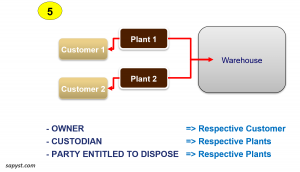
Scenario VI
And finally, if we add a Logistic Service Provider to the previous scenario, we could have a case where the stock is already owned by our customers, but the stock is located in third-party warehouse (custodian). While the Parties entitled to dispose of it remain the two plants.
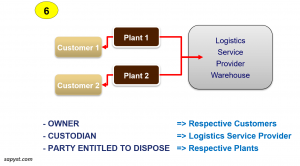

Recent Comments